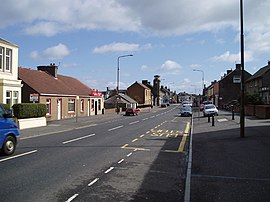Armadale, West Lothian
Armadale
|
|
|---|---|
 Coia's Sweet Shop and The Goth, looking eastwards. |
|
| Armadale shown within West Lothian | |
| Population |
9,063 (2001 census) |
| OS grid reference | NS935685 |
| Council area | |
| Lieutenancy area | |
| Country | Scotland |
| Sovereign state | United Kingdom |
| Post town | BATHGATE |
| Postcode district | EH48 |
| Dialling code | 01501 |
| Police | Scottish |
| Fire | Scottish |
| Ambulance | Scottish |
| EU Parliament | Scotland |
| UK Parliament | |
| Scottish Parliament | |
9,063 (2001 census)
Armadale (Scots: Airmadale, Scottish Gaelic: Armadal) is a town within the district of West Lothian in central Scotland. Armadale, formerly known as Barbauchlaw, is an ex-mining town which is also known for its brick manufacturing. It is named after Armadale in Sutherland, this estate being owned by Sir William Honeyman who later acquired the land of Barbauchlaw.
The town has a great number of different public places. There are eight public bars in the town - Coppies Bar, The Corrie, The Kross Bar, The Cavalier, The Bucks Head Tavern, The Highlander, The Regal, and The Goth, which provides the town clock at the front of the building. There are local shops like Coia's Sweet Shop, Coia's Fish and Chip shop, John Dewar and Sons Butchers and more. The main feature of Armadale is The Cross. There is also a small Scotmid supermarket on West Main Street.
Armadale (Woodend Farm) is officially the site of Ogilface Castle. Woodend Farm has another site nearer Blackridge, marked as 'Ogelface in ruins' on a 1773 map. These sites have been the subject of archaeological geophysics surveys by the Edinburgh Archaeological Field Society and Dr Peter Morris and kite aerial photography by the West Lothian Archaeological Trust which now also manages the Armadale Community and Heritage Website.
Before the building of a new turnpike road between Edinburgh and Glasgow in 1786 the village of Armadale was little more than a rural farm community but its location at a main highway junction brought additional traffic and a toll house was built where the new road intersected with an existing road in the east of the estate. The estate comprising the lands of Barbauchlaw was sold to Sir William Honeyman in 1790 and upon his elevation to the bench in 1797 he took the title of Lord Armadale (from his mother's estate in Sutherland) and this name was then applied to the township
...
Wikipedia

